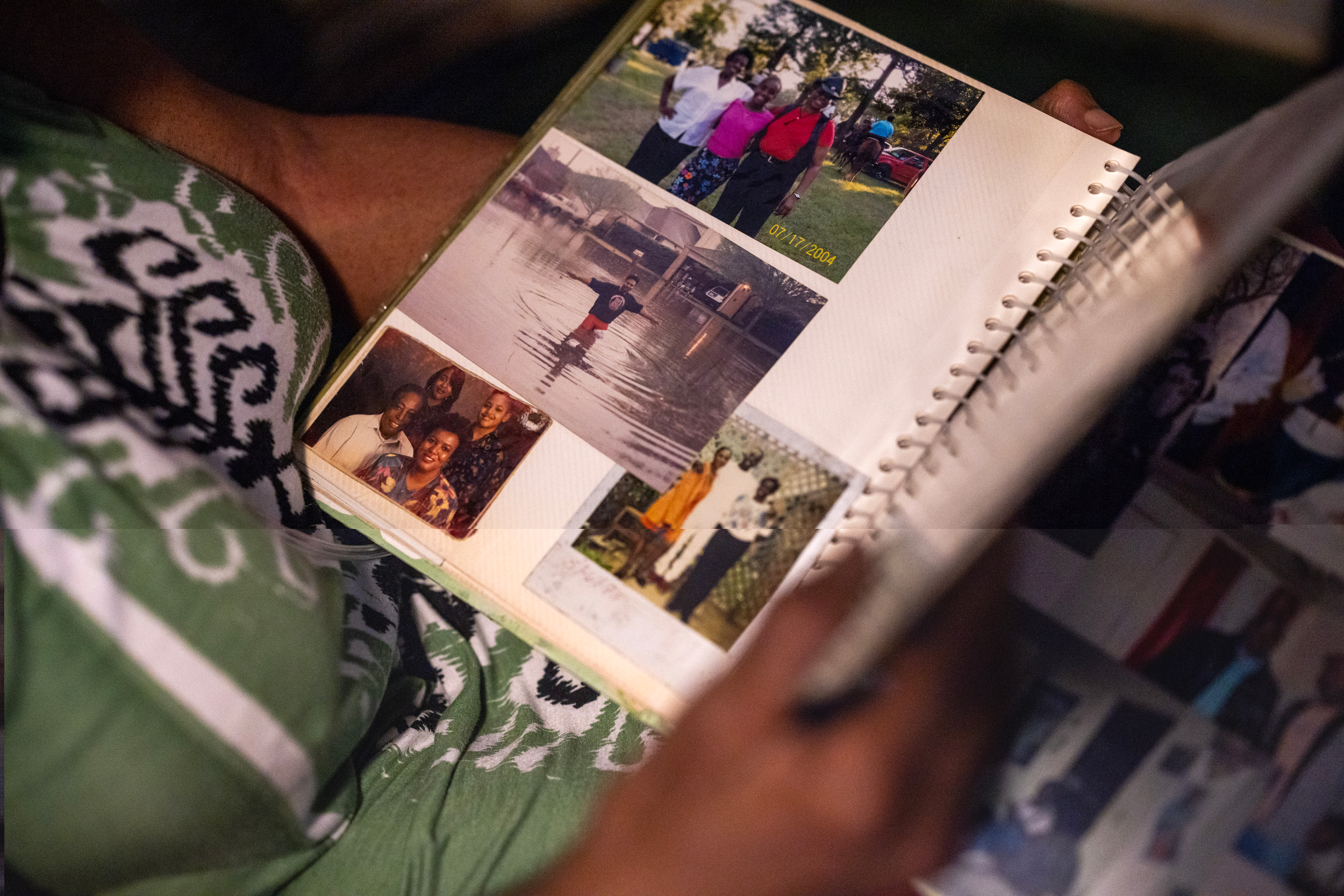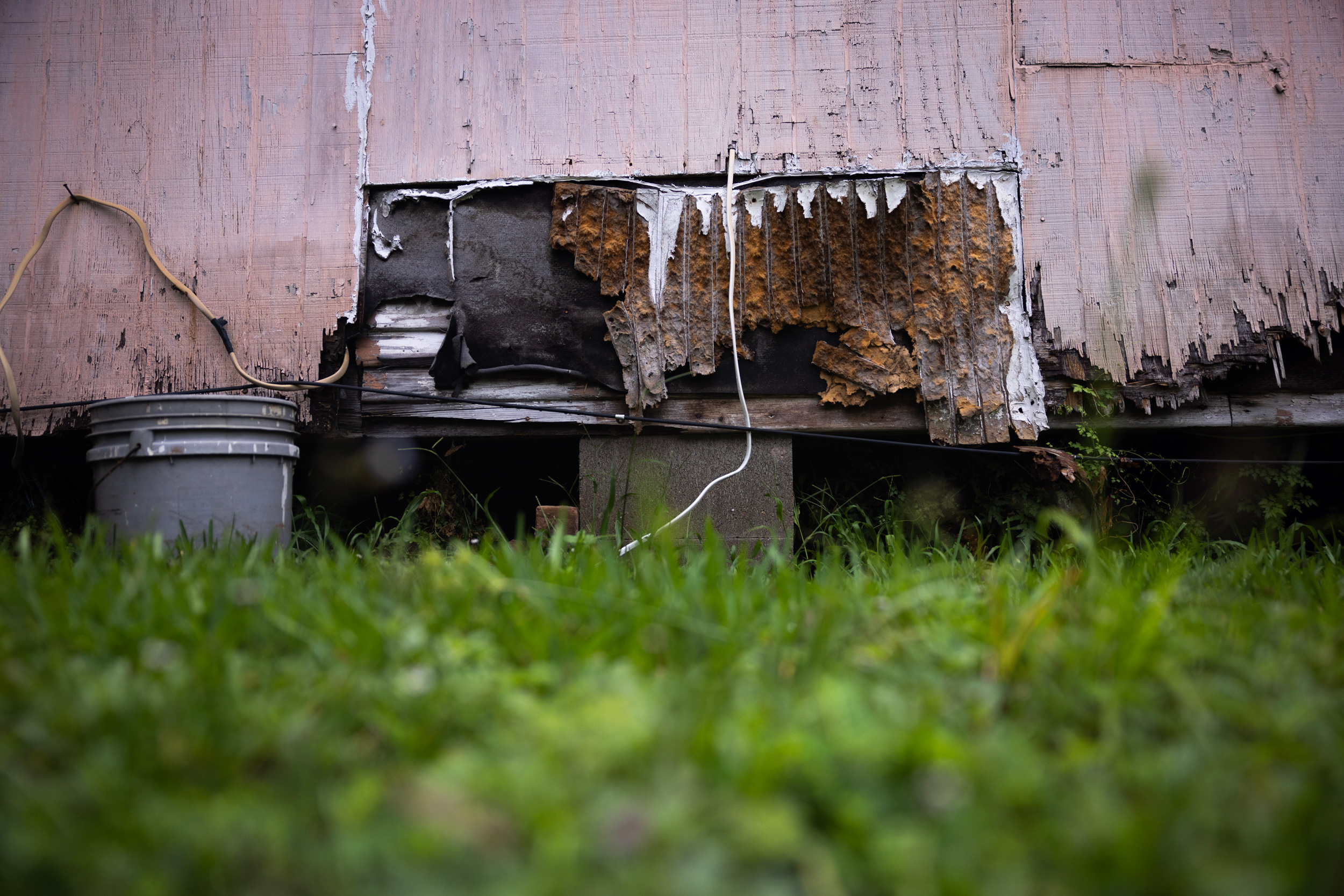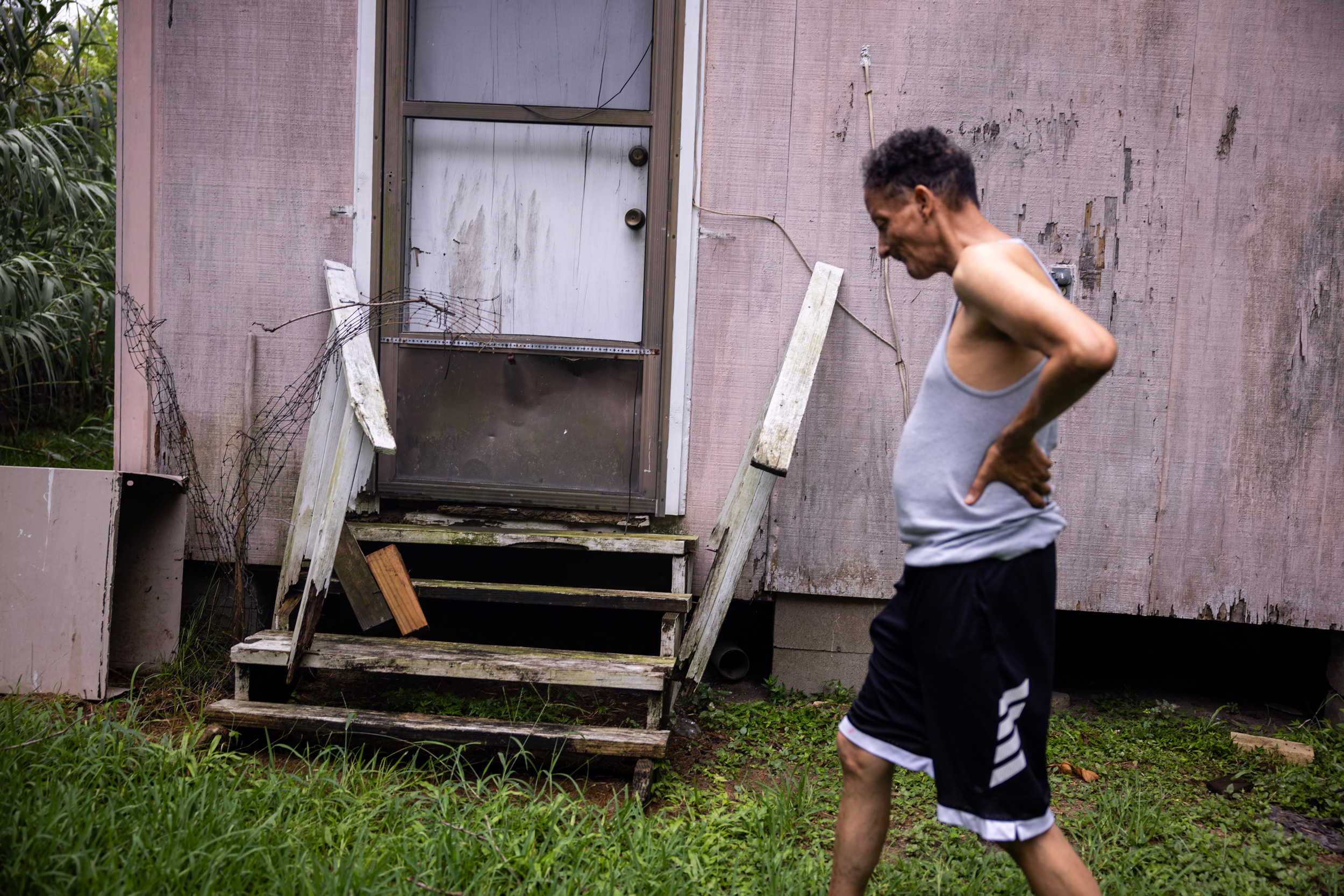|
Getting your Trinity Audio player ready...
|

The ground around Jessie Jacobs’ house is water-logged — again. It’s a Friday afternoon in early July, and Houston has finally received a splash of rain to break this wretched heat spell. That brief shower brought the temperature down a few degrees, and provided a mini thirst-quench to the city’s scorched grasses.
Many of us had hoped for this rain. Prayed for it, even.
But at Jacobs’ house in Acres Homes, rain is an unpleasant reminder of the wettest week this city has ever seen: The five-day, 51-inch dump of water from Hurricane Harvey. It’s been six years, and while much of the city has largely recovered, Jacobs’ home still holds visual scars, like the blue tarp affixed to the roof above the dining room where she sits now.
That tarp — that universal sign that a Houston home has suffered debilitating, yet-to-be-remediated storm damage — stopped some of the morning’s rain from coming inside. But there are ceiling bubbles and places where spackle bulges and buckles — signs that one lonely tarp cannot keep the house that once belonged to Jacobs’ parents completely dry.
She’s tried to have it fixed. And she’s tried to live with it — to be resilient. But being resilient is exhausting.
‘Houstonians are resilient’
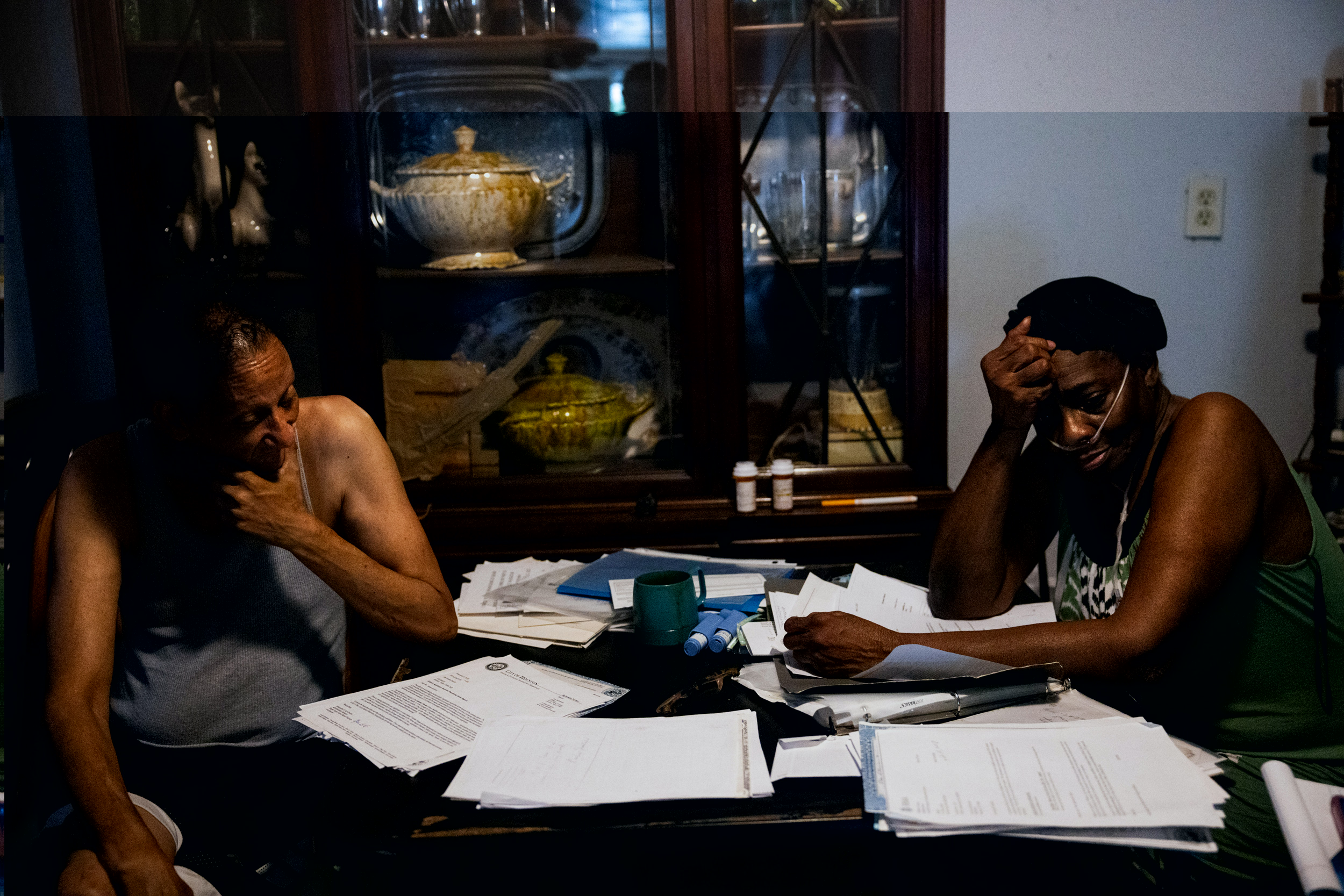
Chances are if you live in Houston, you’ve considered the idea of resilience before. You’ve probably even used it to describe yourself, or the vision of yourself you want to be. The term has been batted around with increasing frequency over the past several years as the Houston area pivots from one disaster to the next. A quick dive into Google data shows searches for “resilience” hit a new high in September 2017, as we mopped our way out from under Harvey’s deluge.
I’ll never forget those first days and weeks during and after that landmark storm, when I waded through this city — sometimes with a reporter’s notebook, talking to residents who’d lost so much, and other times as a house-mucking volunteer wracked with survivor’s guilt for coming out unscathed myself. During those sodden times, I came to expect that within the first few minutes, I’d hear that word: resilient.
We Houstonians are resilient.
I heard it from flood victims and survivors, from public officials and disaster-recovery fundraisers. Resilience, it seemed, was everywhere.
It was a promise that said Houstonians who’d been knocked down would find a way to rise again. But that very notion — the one that puts the onus on the person who’s been knocked down — shows the limitations of resilience. The ways it can be used as an excuse, or an absolution, for those who are supposed to create and maintain support structures to protect residents from being knocked down in the first place.
Houstonians are resilient, we say, as we turn a blind eye to a 73-year-old woman with a blue-tarped roof, who can still see rain seeping into her living room six years later. A woman who has seen the roof get worse through Tropical Storm Imelda, Winter Storm Uri and all the other disasters we’ve faced since we began Googling “resilience” in 2017 — this current heat wave included.
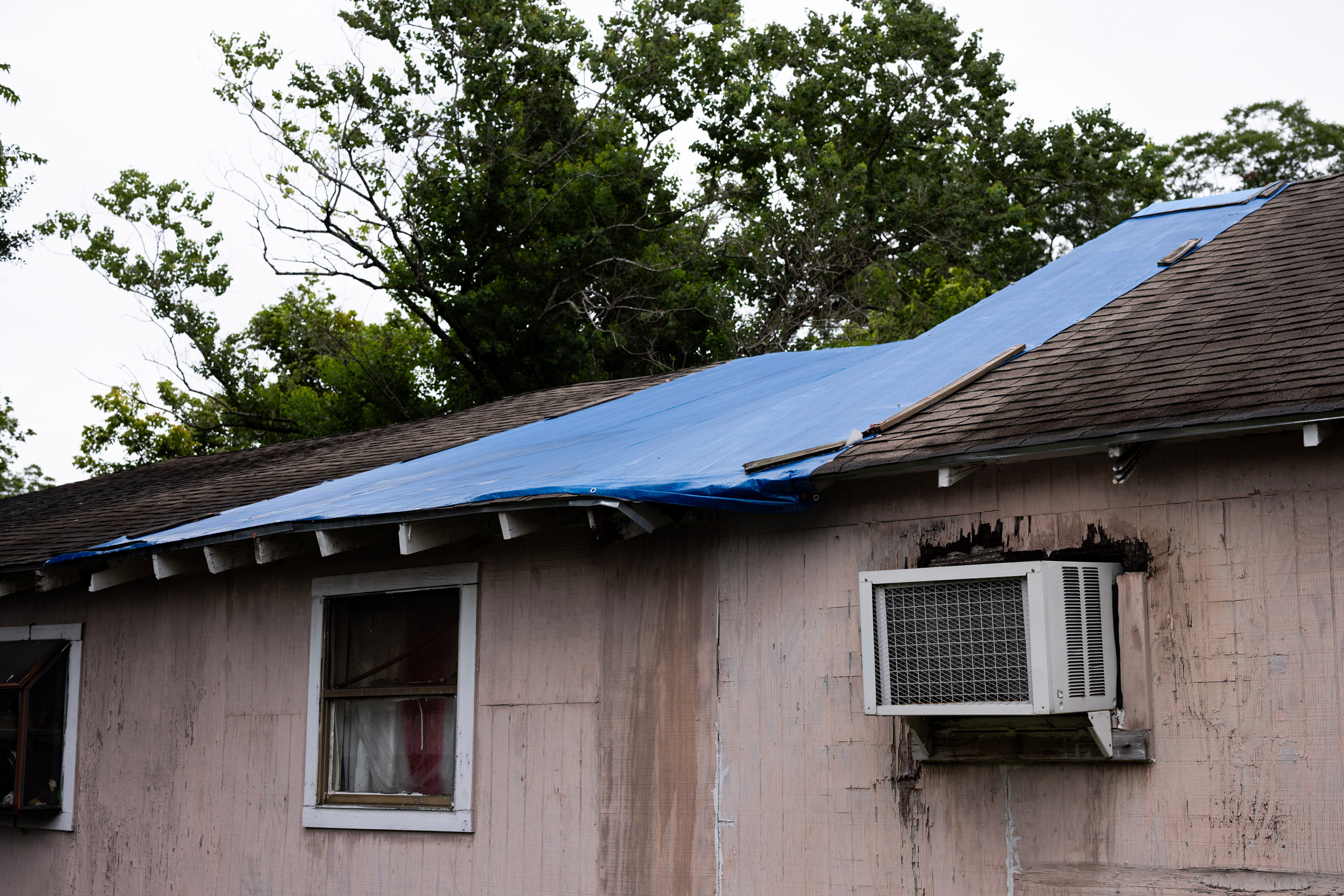
Harvey was too much
Miles away from Jacobs’ home, out to west of Loop 610, residents of Bear Creek Village are watching as the Harris County Engineering Department’s Recovery and Resiliency Division digs into the ground where a neighbor’s home once stood. The subdivision, which sits in the floodplain adjacent to the Addicks Reservoir, saw catastrophic damage when the reservoir filled to unprecedented levels, flooding about 1,400 homes — nearly 60 percent of the neighborhood.
During a ceremonial groundbreaking this June, complete with public officials stomping shovels in too-big hardhats, Harris County Commissioner Lesley Briones noted that the $20.2 million project will improve drainage and mitigate future flooding. She also acknowledged what was on many residents’ minds: Six years is a long time to wait for a solution.
Shelly Schmitz, president of the area’s homeowners association, told me that many of her neighbors have moved on from what has always been their tight-knit community. Harvey was just too much, especially coming just one year after the “Tax Day Floods” — when 240 billion gallons of rain fell on Harris County on April 17 and April 18, 2016.
“We suffered the Tax Day Flood, we had to rebuild. We had 19 inches in our house, but it went out right away,” said Norilda Garcia-Reed, whose house is just a few lots down from the county’s drainage project, which will come together over the next few years. “But 2017 was a different story. Our house ended up with 4-and-a-half feet of water that sat in there for 10 days.”
Garcia-Reed understands why many of her neighbors have left, but she’s still torn.
“I don’t know if we’re going to stay or not after all this time,” she said. “But our house was devastated two years in a row, and I’m too old to be doing this. I’m tired.”
From recovery to resilience
There is a better way to recover and rebuild from disasters, and it’s born from shifting from a reactive ideology to a proactive one. Or at least that’s what United Way of Greater Houston CEO Amanda McMillian and Greater Houston Community Foundation CEO Steve Maislin tell me. At the beginning of hurricane season early this June, Maislin and McMillian’s organizations came together to launch the Greater Houston Disaster Alliance, which will turn disaster response into a year-round effort, regardless of whether skies are rainy or blue.
“A big part of the Disaster Alliance is knowing that one of the first things we can do to be able to recover from a disaster is to be prepared for the next one,” McMillian says. “We don't and can't expect everyone to be fully resilient from disasters. That's not how disasters work.”
So often, she notes, “the most vulnerable parts of our communities are the ones who keep getting hit time and time again.”
The new alliance kicked off with $1.5 million in funding from private companies that Maislin says will allow alliance leaders to establish disaster-ready infrastructure, like fundraising paths and man-or-womanpower to “help almost instantly” when Houston is (inevitably) hit by its next emergency. This shift away from disaster recovery to a more proactive approach, Maislin and McMillian say, will help Houston work toward true resilience.
“Recovery is helping people get back on their feet. Resiliency is helping them stay there,” McMillian says.
Staying optimistic
Houston-area residents recorded their lowest rate of optimism in decades this year, according to the Kinder Houston Area Survey released in May. In January 2017, just months before Harvey barreled into town, 65.1 percent of Houstonians assumed they’d be better off financially in the next three years; this year the figure is down to 50.6 percent.
It’s understandable, given what we’ve all gone through. But Jessie Jacobs still counts herself an optimist — even after six years in a blue-tarped house that gets a little soggier with every storm.

It’s been five years since she was denied aid from FEMA, and almost four since she first reached out to the city for help to fix her roof through the Harvey Homeowner Assistance Program.
Then came the miscommunications and confusion. While Jacobs thought she successfully applied for the program, city records show that she only completed a pre-screening application. When she missed an in-person appointment in November 2019, the city called her to reschedule. But her voicemail was full. They couldn’t leave a message, city officials told me.
Her application was closed out by the city in early 2020. In 2021, the program stopped accepting new applicants.
Jacobs is frustrated. And like the homeowners in Bear Creek Village, she is tired. Six years is a long time to wait for a resolution. But she said she’s not too tired to keep hoping. Resilience, she agrees, is exhausting. But it’s also a form of faith, and that, to her, is a necessity.
Just a few weeks ago, she submitted her paperwork again, this time to the Texas General Land Office, which has assumed control of the federal funds that were once dispensed through the Harvey Homeowner Assistance Program.
“I have the faith of a mustard seed,” says Jacobs, the daughter of a late deacon, as she references a Bible passage.
“You know how little that mustard seed is, now?” she continues, wiping sweat from her brow as a box fan whirs a few feet to her left, supplying whispers of chilled air on a hot afternoon. “And it will move a mountain.”
Share your Houston stories with me. We can start on Twitter, Facebook and Instagram. Or you can email me at [email protected].


